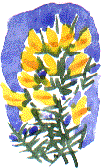 
Skokholm SentinelSaturday 6th May 2000 THERE IS A GALLERY of bird paintings on the whitewashed wall of the outhouse which houses the Elsan chemical toilet (there's no running water on Skokholm). It has been featured in a BBC television documentary of 'loos with a view. There are now thirty or more bird portraits, painted directly on the wall by island workers or visitors at the time the rarer bird visitors showed up. I have vague memories of painting a duck there on a previous visit and, there it is on the wall; a female Eider. I didn't see the bird myself, it was one that the warden had recently spotted in the harbour. When I look at the old painting, it's not quite in my normal style. If I remember rightly, I used emulsion paint tinted with watercolours for the background, with brown Indian ink for the plumage. It goes back not ten years, to my last visit, as I'd at first thought, but twenty years, to the visit I made when I was working on my Britain sketchbook for Collins. 'If some future archaeologist finds that,' says Eric, one of this week's visitors, 'he'll think that Skokholm was some kind of centre for the worship of birds.' I think Skokholm is some kind of centre for the worship of birds!
After breakfast, packing and washing up, I've got time for one last circuit of the island before the boat arrives at lunchtime. I sketch the one of the Ravens standing sentinel on a rocky outcrop above the nest on a ledge high on the cliff face above Mad Bay. There is just one chick, and that looks as if it will soon be ready to fly. Some of its tail feathers are still wrapped in white quills. It explores the narrow ledge alongside the nest. I've returned the watercolours, with thanks, so I use a brush improvised from a few scattered shearwater feathers, stuffed into the hollow end of a wing bone.
I didn't realise how tricky loading and unloading a boat can be. The spring tide rises and falls quickly. The skipper says he's only got a bowl of soup beneath the boat, and he pulls back. The groceries are loaded into a rubber dingy to be taken ashore. Tins, bread, crates cabbages and mushrooms are piled up in the little dingy, like an overfilled shopping trolley, as it bobs up and down alongside.
   Marloes to Dale  Back on the mainland, by the clifftop path above Marloes Sands, Stonechats feed their young on caterpillars.
Back on the mainland, by the clifftop path above Marloes Sands, Stonechats feed their young on caterpillars.Ravens give their croaky, honking calls as a Buzzard flies into their territory. In the evening I take a walk around the headland near the little harbour village of Dale. The sun is going down in a pearly sky behind Skokholm, which lies like a long slug (the lighthouse as a stalked eye) stretched across the glittering water. It's misty, so the rugged island, from this distance, looks no more substantial than a watercolour brushstroke. The naturalist R.M.Lockley, who died a only a few weeks ago, described life on Skokholm and his pioneering work on the behaviour of sea birds in his book Dream Island. This evening, that's the way it looks to me. Skokholm seems as much a state of mind as a physical location. I hope I'll return some day. As I say, since 1970 I've returned at ten year intervals like some wandering turtle. Back on the island everything seems, more or less, as it always was. I have a sneaking feeling that my real life is my life on the island rather than the intervening decades in the crazy world that passes for 'normal' everyday life back on the mainland. I'm reminded of Prospero's decision to leave his magical island and return to the everyday world. On the island you feel the full rhythmn and flow of nature. It is hard to go back to a world so blinkered and petty that you can be, as I was, threatened with financial ruin when you stand up to try and stop the destruction of a beautiful meadow.
 With its pointed, slightly down-curved, beak a Chough probes the turf by the lighthouse at the end of the headland. It gives its 'Chack!' call, a more ringing version of the jackdaw's, and flies off. For a crow, it has a small head but broad wings, fingered at the ends, so in flight it looks a bit like a large black butterfly.
With its pointed, slightly down-curved, beak a Chough probes the turf by the lighthouse at the end of the headland. It gives its 'Chack!' call, a more ringing version of the jackdaw's, and flies off. For a crow, it has a small head but broad wings, fingered at the ends, so in flight it looks a bit like a large black butterfly.After my spell on the island it is a shock to abruptly get back to a monoculture - in this case a lush green crop of grass or barley - as I cross a style and leave a protected part of the coast managed for its landscape and return, for a couple of fields, to the working landscape. Almost every square foot of turf on the island is different to the next. After three four days of variety I find this uniform green perfection looks unnatural. The wild flowers are suddenly missing from the adjoining field edges; rank nettles thrive on the overspray of fertilizer.
|